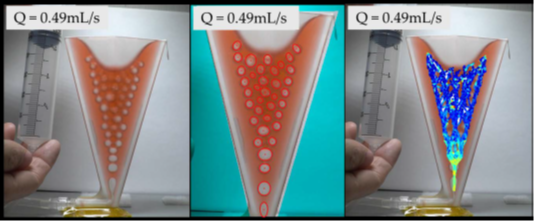Analysis of Capillary Nucleate Boiling Experiments in Microgravity
2023 - Dr. Sarah Morris

On earth, heat transfer away from a heated surface can easily be achieved by nucleate boiling, as buoyancy due to gravity ensures that the gas bubbles that form rise to the liquid surface. In the microgravity environments found aboard spacecraft, this seemingly simple task becomes non-trivial as bubbles and heated liquid do not rise while droplets and cooler liquids do not fall. In cases of high heat flux, wall-bound vapor bubbles coalesce blanketing the heated surface leading to premature dryout and subsequent burnout of the surface. In 2022, a series of demonstrations were performed by astronaut Kjell Lindgren aboard the International Space Station (ISS) exploiting conduit geometry to mimic steady nucleate boiling. The `boiling flask' container employs a tapered rhombic section capable of passive bubble separation in a manner that replaces the role of gravity during nucleate boiling on earth. The analogous isothermal demonstrations introduce air bubbles into the flask vertex at a nearly constant rate. Here, the partially asymmetrically confined bubbles lead to displacement co-flows, and the bubbles are driven away from the vertex. The bubbles are driven downstream where they merge with the ‘free surface' and escape the liquid. In this work, the bubble migrations are analyzed using particle tracking velocimetry (PTV). Additionally, a numerical tool was developed to predict such bubble migrations using the open-source computational fluid dynamics software OpenFOAM. Simulations are benchmarked against the experimental results from the ISS. Using both the experimental and simulation data, it is observed how the bubble trajectories and velocities and liquid co-flows are dependent on the gas injection flow rate, bubble volume, and conduit geometry.
